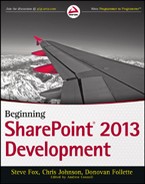SUMMARY
In SharePoint 2013, workflow has been decoupled from the SharePoint server and runs as the Workflow Manager Server in on-premises installations and as Workflow Manager Service in the cloud. The new workflow engine is written according to the new cloud app model architecture, leveraging the REST _API to call back into SharePoint via the OAuth protocol and employing Windows Azure Service Bus to provide its messaging framework and durable event management.
The tools the business analyst, SharePoint subject matter expert, and developer continue to use are Visio Professional, SharePoint Designer, and Visual Studio, respectively, but these tools sport a host of new features for building workflows. Visual Studio can be used to build custom actions that can be installed into SPD to provide additional productivity gains for those creating workflows.
Lastly, workflows fit very comfortably inside your Apps for SharePoint. Those who are skilled at developing workflows in Visual Studio can build workflows around very common business process scenarios, package them up as an app, and get them into the SharePoint Store on Office.com. Also, because these workflows are XAML-based, they can run equally well both on-premises and on Office 365.
WHAT YOU LEARNED IN THIS CHAPTER
| ITEM | DESCRIPTION |
| Workflow Manager | This is the new workflow engine that hosts workflows and runs as a server on-premises and as a service in Windows Azure. |
| Visio Professional 2013 | Visio has a new .VSDX XML-based file structure that SharePoint Designer can natively read. The need no longer exists for the .VWI interchange file between these two products. This provides a new portability option for exporting full workflows out of SPD into the .VSDX file, and then importing them into any other SPD site or back into Visio for further work by a business analyst. |
| SharePoint Designer 2013 | A new Visual Designer was added to SPD along with many new actions that make workflow design much more person-process oriented rather than a linear top-to-bottom flow. |
| Apps for SharePoint | Workflows are also first-class participants in Apps for SharePoint and can be delivered as a part of a solution into the SharePoint Store. |
